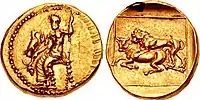Mazaeus | |
|---|---|
 Possible coin of Mazaeus | |
| Native name | Mazaios |
| Born | 385 BC |
| Died | 328 BC (aged 57 years) Babylon |
| Allegiance | Achaemenid Empire, Macedonian Empire |
| Rank | Satrap of Cilicia (under the Achaemenids) Satrap of Babylon (under Alexander the Great) |
Mazaeus or Mazday (Aramaic: 𐡌𐡆𐡃𐡉 MZDY, Greek: Μαζαῖος Mazaios)[1] (died 328 BC) was an Achaemenid Persian noble and satrap of Cilicia and later satrap of Babylon for the Achaemenid Empire, a satrapy which he retained under Alexander the Great.[2]
Life
Mazaeus was the penultimate Persian satrap (governor) of Cilicia. His successor in Cilicia was Arsames, who was ultimately expelled by Alexander the Great.
At the Battle of Gaugamela, Mazaeus commanded the right flank with the Syrian, Median, Mesopotamian, Parthian, Sacian, Tapurian, Hyrcanian, Sacesinian, Cappadocian, and Armenian cavalry.
As a reward for his recognition of Alexander as the legitimate successor of Darius, Mazaeus was rewarded by being able to retain the satrapy of Babylon, as a Hellenistic satrap.[2] Alexander left a Macedonian, Apollodorus of Amphipolis, as the military commander of the garrison of Babylon, and another as tax-collector.[2] Mazaeus continued minting coins under his name, and later without his name.
The daughter of the Persian king Darius III, Stateira II, was originally betrothed to him, but he died before they could be married. She was eventually married to Alexander.
Waldemar Heckel suggested that the Alexander Sarcophagus might have been dedicated to him.[3]
Mazaeus was replaced as satrap of Babylon by Stamenes.[4]
Coinage
Mazaeus had an abundant coinage, which he minted in Tarsos, Sidon and Babylon. Coinage as Satrap of Cilicia

._Circa_353-333_BC.jpg.webp) Mazday (Mazaios) as ruler of Sidon. Circa 353-333 BC.
Mazday (Mazaios) as ruler of Sidon. Circa 353-333 BC.

Coinage as Satrap of Babylon
 Coinage of Mazaios as Hellenistic Satrap of Babylon, circa 331-328 BC.
Coinage of Mazaios as Hellenistic Satrap of Babylon, circa 331-328 BC. Late coinage of Mazaeus as satrap of Babylon.
Late coinage of Mazaeus as satrap of Babylon.
References
- ↑ Metcalf, William (2012). The Oxford Handbook of Greek and Roman Coinage. Oxford University Press USA. ISBN 978-0-19-530574-6.
- 1 2 3 O'Brien, J. M. (2003). Alexander the Great: The Invisible Enemy: A Biography. Routledge. p. 94. ISBN 9781134845019.
- ↑ Heckel, Waldemar (2006). "Mazaeus, Callisthenes and the Alexander Sarcophagus". Historia. 55 (4): 385–396.
- ↑ Roisman, Joseph (2002). Brill's Companion to Alexander the Great. BRILL. p. 189. ISBN 9789004217553.
